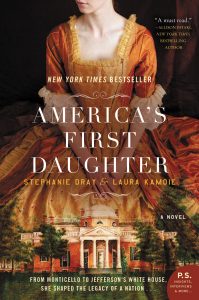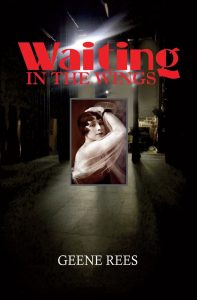In the Dark Streets Shineth by David McCullough
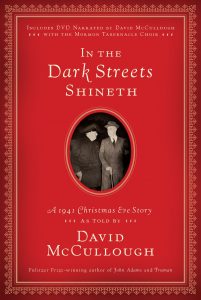 In the Dark Streets Shineth packs alot of Christmas spirit in a very small book.
In the Dark Streets Shineth packs alot of Christmas spirit in a very small book.
Written by author and historian David McCullough, it recounts the infamous meeting of Churchill and Roosevelt during Christmas of 1941.
Churchill traveled in great secrecy and at considerable risk across the ocean to meet with President Franklin D. Roosevelt.
Roosevelt poses the question; How we can celebrate Christmas because of the war?”
And, so they both spoke from the Whitehouse balcony to a crowd at twilight Christmas Eve. A reporter notes
A crescent moon hung overhead. To the southward loomed the Washington Monument …as the sun dipped behind the Virginia hills.
Both speeches are in the book so I’ll only quote a few lines which moved me.
Our strongest weapon in this war is that conviction of the dignity and brotherhood of man which Christmas Day signifies. Roosevelt
Therefore we may cast aside for this night at least the cares and dangers which beset us, and make for children an evening of happiness in a world of storm. Churchill
Christmas morning, Churchill and Roosevelt attended Christmas services together and they sang Oh Little town of Bethlehem, which Churchill had never heard before.
The book has numerous and rare photos from the World War II meeting — photos of the meeting but also of the Roosevelt family celebrating in the Whitehouse.
Here they are on the White House Balcony…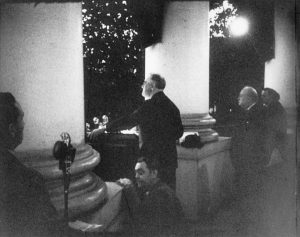
The book goes on to share the stories behind the traditional Christmas carols ~~ Oh Little town of Bethlehem and I’ll be Home for Christmas.
There’s a DVD included with this book — in it, David McCullough presents the story at the Mormon Tabernacle Choir’s 2009 Christmas concert.
See what I mean? Quite the little book, and well worth adding to your Christmas book collection.
The Jane Austen Project by Kathleen A. Flynn
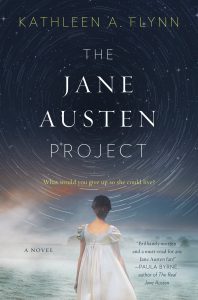 After my last slow, careful reading of Crossriggs, I wanted my next book to be an easier read. But my mind was reluctant to leave the 19th Century. Then, lo and behold, my requested copy of The Jane Austen Project came through from the library.
After my last slow, careful reading of Crossriggs, I wanted my next book to be an easier read. But my mind was reluctant to leave the 19th Century. Then, lo and behold, my requested copy of The Jane Austen Project came through from the library.
I dashed over to my branch, and read the back cover blurb as I walked home — (What do you say, you don’t read and walk? It can be done, albeit carefully in a city) — A Jane Austen time travel piece? Why yes — yes please. Book Barmy readers know I’m a sucker for time travel books.
Dr. Rachel Katzman and Liam Finucaneis come from a technically advanced future where food is 3-D generated, there’s been an ecological die off, and time travel has become successful. As part of a scientifically sanctioned journey, Rachel and Liam are selected and rigorously trained to travel back to 1815. Their assignment is to meet and befriend Jane Austen in order to bring back a trove of lost letters, as well as an unpublished manuscript.
The book opens with our couple waking up from their time travel in a damp Surrey field in 1815, and in forthcoming pages we quickly learn the backstory and the premise of their time travel assignment.
In order to meet Jane Austen, their first task is to integrate themselves with Henry Austen, her favorite brother. They pose as brother and sister, William and Mary Ravenswood from Jamaica looking for investments with Henry who owns several banks in 1815 London. They find a flat in London, purchase clothing, hire servants and begin their adventure.
There much to enjoy in discovering The Jane Austen Project first hand, so I won’t tell you much more about the plot — at the risk of ruining it for you. But I will tell you that Ms. Flynn, an Austen scholar, has created a most realistic time of Jane Austen.
Her descriptions are stellar, giving the reader a true feel of the London streets, the stark contrast of poverty versus the gentility, the food, the servants, the country estates, and the clothing — turns out, 19th century men were the true fashionistas.
I sighed in envy over a scene where William and Mary (Liam and Rachel) go book shopping for Jane Austen’s contemporaries at none-other than, London’s Hatchard’s Bookstore which is still in operation today, just as it has been since 1797.
The Jane Austen Project shines with vivid authenticity, the author weaves in colorful details of the Austens’ lives — how they looked, their family dynamics, their travels, and the state of their health. Ms. Flynn also nails the time period details — manners, morals, habits, and gender roles. Mary (Rachel) is a doctor, but can not publicly use her skills when first Henry, and then Jane, falls ill. She must have William (Liam) pose as a doctor and she advises him from behind the scenes.
The usual time travel rules (yes, there are time travel rules don’t ya know) insist travelers do not impact history. But, right or wrong, Ms. Flynn allows her time travelers to be human, interact with the people of the time and indeed effect small changes. When Mary (Rachel) observes her first chimney boy crawling up her chimney to clean it, she is horrified and pays his boss to release the alarmingly young boy to her custody. Then there’s the scene where Fanny (yes that Fanny) is choking and Mary (Dr. Rachel) automatically uses the Heimlich maneuver, unheard at that time. When Henry Austen proposes marriage to Mary, she must put him off for as long as it takes to complete their assignment. Also, there are changes (obviously fictional) to Jane Austen’s later novels, but I’ll let you discover those imaginative bits for yourself
For me, the pure joy of The Jane Austen Project were the scenes with Jane Austen, Henry, her sister Cassandra, and the various friends and family who are (or will become) characters in her novels. If you’re like me, you’ll hold your breath when our intrepid travelers finally get to meet and share tea with Jane.
Jane, herself, is depicted with a quick intelligence, quiet intensity, and a keen ability to read others. And in 1815, she has already published some of her works. Just imagine being a fly on the wall during this scene where Mary (Rachel) and Jane Austen discuss Pride and Prejudice:
She (Jane) laughed. “Life is full of such oddities is it not? How did Mr. Darcy happen to fall in love with Elizabeth Bennet, when he could have had any lady in the kingdom?”
“Because you made her so lovable?”
“Oh, yes, perhaps that was why.”
While the premise of The Jane Austen Project may seem preposterous (and perhaps it is), this is a fascinating re-creation — an escape into the world of Jane Austen — and I loved every moment of my imaginary and wonderful journey.
Nina Sankovitch
Every so often, a reader can’t help but form an instant connection with an author. Especially when they share a passion for the same things. That’s just what has happened with me and the author Nina Sankovitch. These two books delve into two of my favorite things — a love of reading and a fascination with old letters.
Imagine the chats we could have over a cup of tea…
Back in 2012, I read Tolstoy and the Purple Chair
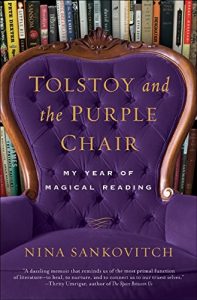 Ms. Sankovitch lost her beloved sister, Ann-Marie, to cancer at age 46. Reading was a lifelong passion for them both. During Ann-Maire’s final months in the hospital, Ms. Sankovitch read aloud to her — spending as much time together as possible during her last days.
Ms. Sankovitch lost her beloved sister, Ann-Marie, to cancer at age 46. Reading was a lifelong passion for them both. During Ann-Maire’s final months in the hospital, Ms. Sankovitch read aloud to her — spending as much time together as possible during her last days.
After her sister’s death and overcome with grief, Nina decides that the same passion that bonded her with her sister and carried her through her life will be her therapy. She will read a book a day for a year.
A book a day, I wondered? Even I, a voracious reader, can’t compete with a book a day. These were her rules:
• She would read only one book per author,
• She would not re-read any books she had already read,
• She would limit her choices to books that were no more than one inch thick, ensuring that they would, for the most part, be in the range of 250-300 pages each,
• And she would only read the kind of books she and her sister, Anne-Marie would have enjoyed together.
For those of us who want to read about what someone else is reading, Tolstoy and the Purple Chair takes us on her journey, as she reads from her favorite purple chair.
She shares her epiphanies and discoveries — all from the pages of her carefully chosen books. She intersperses her bookish insights with memories of her sister and of growing up in a bookish immigrant family who instilled in her the belief that books are not a luxury, but a necessity.
Never fear, this is not a grim tale of a painful year, nor is it an instruction manual for grieving. Ms. Sankovitch gives us a book straight from her heart, full of hope and wisdom. It’s about stopping the merry-go-round of a busy life to read, think and learn.
This book will appeal to any bibliophile, but especially for those of us who turn to books for answers, comfort and wisdom.
 Signed, Sealed, Delivered begins with Ms. Sankovitch’s discovery of an old steamer trunk she finds in her backyard which holds hundred year old letters written by a Princeton freshman, James Seligman, to his mother in the early 1900s.
Signed, Sealed, Delivered begins with Ms. Sankovitch’s discovery of an old steamer trunk she finds in her backyard which holds hundred year old letters written by a Princeton freshman, James Seligman, to his mother in the early 1900s.
These letters are fascinating, as he reports on an explosion in the J.P. Morgan building, comments on Roosevelt’s presidential campaign, and the death of his uncle on the Titanic. His letters are dry and acerbic, but filled with details.
Ms. Sankovitch’s book goes on explore the history of letter writing and we get to read correspondences ranging from the ancient Egyptians, to medieval lovers, to letters exchanged between Samuel Morris Steward, Gertrude Stein and Alice B. Toklas — the latter, some racy and fun reading.
Her section on the letters President Lincoln received after his son’s, Willy’s, death, revealed a rare bit of history. Franklin Pierce and family were in a train crash on their way to Washington DC to take office in 1853. Thrown from the carriage, Pierce and his wife watched helplessly as their son was hit and killed by the still-moving train. Pierce was writing from his own similar experience when he penned his heartfelt condolences to Abraham Lincoln.
Ms. Sankovitch interweaves her own experiences and correspondences with well-researched accounts of other letter writers in history. I love to read other’s correspondence, peeking into their day-to-day lives, hopes, and dreams.
The book is a love story to the lost art of letter writing, a wonderful way to glimpse into history and relationships — all revealed through letters:
“A written letter is a one-of-a-kind document, a moment in time caught on paper, thoughts recorded and sent on, a single message to a special recipient.”
“Sir, more than Kisses, letters mingle souls. For thus, friends absent speak” John Donne, “To Sir Henry Wollow”
Ms. Sankovitch’s own son is heading off to Harvard, and she hopes that he will write to her, as the Princeton student wrote to his mother and as Nina wrote to hers — but she knows she will have to settle for emails or text messages.
“Yes, I am waiting for an answer to my letter but waiting is not my main activity. To be dependent on e-mail and text is to have access to immediate response — but diminishes the rich opportunities that come from living with delayed gratification. For so much happens in the delay.”
This book made me think about future generations. Somehow, I suspect that no one is saving emails and text messages in old trunks. Without letters — from those who made history, shared their love for each other or, just reported on their routine lives — how will we know those long dead?
Luckily I have boxes of old letters, filled with letters from teenage pen-pals, past loves, from Husband, parents, grandfather and those I wrote to my family when I was away at college. Some rainy night – I will revisit those.
Thanks to Simon and Shuster for a an advanced readers copy of Signed, Sealed, Delivered
Monticello by Sally Cabot Gunning
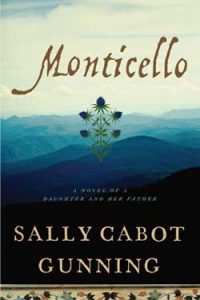 I hope you will forgive me, but I will quote a professional review which captures perfectly, the book I just finished — Monticello by Sally Cabot Gunning.
I hope you will forgive me, but I will quote a professional review which captures perfectly, the book I just finished — Monticello by Sally Cabot Gunning.
“A brilliant exploration of what it meant to be a slave owner in antebellum Virginia where farming depended on slaves, and their presence in the household gave them an intimacy with family members that could be both comforting and threatening. This story of Thomas Jefferson’s devoted daughter, the indomitable Martha Jefferson Randolph, helps us understand all the complexities and contradictions endured by Martha and her family as they struggle with their consciences and responsibilities toward their families, their plantations, and the people who work for them. Highly recommended as an engrossing tale of a strong woman in tumultuous times, with deftly interwoven historical details that make her trials all the more authentic.”
— Library Journal
Historical fiction fascinates me, but only when the author doesn’t stray too far from actual events. Ms. Gunning based this historical novel on actual correspondence between Thomas Jefferson and his eldest daughter Martha. The author says:
As soon as I came across a letter the fourteen year-old Martha Jefferson wrote: “I wish with all my soul that the poor Negroes were all freed . . .” I was hooked. I read all of Martha’s letters to her father and his to her.
The book follows Martha Jefferson Reynolds, her revered father Thomas Jefferson, and their families as they live their lives and make history at Monticello during the late 1700’s to early 1800’s.
Martha adores her father and wishes nothing more than to work with him to build and manage the Monticello plantation. But her relationship with her father is complicated not only by the entire issue of slaves, but the intimacy between her father the coddled slave, Sally Hemings.
While this strained relationship with her father is crucial to her life, the majority of the book is devoted to her difficult marriage. Martha marries Tom Randolph and over the years, gives birth to 12 (yes 12!) children. Martha and Tom struggle. Tom is often depressed and their financial failures and dependence on Thomas Jefferson further threatens their marriage.
(One reviewer pointed out that Thomas Mann Randolph is portrayed unfairly as a weak, paranoid alcoholic who lived as a parasite on the goodwill of Thomas Jefferson. Despite the fact he served in both houses of the Virginia Assembly, became a Congressman and then Governor of Virginia.)
Monticello plays a wonderful backdrop in this novel. Nestled in the beautiful Blue Ridge Mountains, we see how the gardens were treasured. How Jefferson experimented with crops and imported plant seeds. Descriptions of the clothing, home furnishings, and architectural details of Monticello allows the reader to see it as a true home where Jefferson escaped his political worries and thrived.
But we can’t escape the fact that Monticello was a working plantation with slaves. And, even though Thomas Jefferson spoke out against the institution of slavery, at the same time he owned slaves of his own – and fathered numerous children with one of the them (Sally Hemings).
Monticello (the book) gives insight into this Jeffersonian paradox, and what is today, totally incomprehensible. We see plantation life in all its light and darkness, not to mention the usually caring, but sometimes cruel human interaction of slave and master.
Through Martha’s eyes we see Thomas Jefferson as a beloved father, an architect of our constitution, a renaissance man, and an intellectual. But most importantly, we also see him as just a man, like any other man in any other time period — struggling with the political tsunamis and conflicting morals of his time.
I was thoroughly lost in the pages of Monticello and had trouble putting it down. When I did have to stop reading, (you know meals, sleep, showering, those pesky interruptions) it took me a bit to clear my mind and return to current day life.
Monticello is one of my favorite historic sights and you must visit, but in the meantime you can see Jefferson’s library HERE. (It’s swoon-worthy)
N.B. The day after I finished this book, I purchased this other novel about Martha Jefferson. It was my birthday, I’d hurt my back and I didn’t need any more excuses — and so it goes. Another Jefferson read awaits me.
Waiting in the Wings by Geene Reese
Waiting in the Wings, by Geene Reese
Even though I’ve lived in San Francisco for 35 years, I never tire of its physical beauty, architecture, diverse culture, and most of all, this city’s colorful, and often, disreputable history.
So, I was very excited to receive Waiting in the Wings, a historical novel set in prohibition-era San Francisco and based on the true story of the author’s great aunt.
From the introduction: Hidden in a compartment of my grandmother’s bottom dresser drawer was an old scrapbook. Pressed inside were photographs of a beautiful young woman and hundreds of newspaper clippings about vaudeville shows and the movie industry. This, is how I learned about my great aunt Ruby Adams.
This is no dry historical biography, in just the first pages, both Ruby, a beautiful, spunky vaudeville performer, and 1920’s era San Francisco sparkle to life. For a San Franciscan, the opening chapter is pure delight as we walk the sidewalks of the city with Ruby — leaving the original St. Francis Hotel, crossing street-car-crowded Market Street, and into the historic Strand theater. On our way, doormen greet her and others smile in delight –everyone knows Ruby and her delightful vaudeville review.
This is a time of transition for vaudeville theater, as the moving picture industry is starting to encroach. Ruby, with her striking looks, is contemplating a move to moving pictures, but still gaily performs her vaudeville routine in the historic theater where she practically grew up.
We join Ruby as she prepares for her nightly performance, observing both the back stage workings and the show performance itself. We are also with Ruby, that fateful evening, when she is injured in a back stage accident.
Ruby’s injuries are extensive and the accident, upon investigation, reveals negligence. Her career over, Ruby files a lawsuit…and here Waiting in the Wings takes a compelling turn. Ms. Reese takes us into the corruption and prevailing attitudes of the time, with unscrupulous lawyers and shady dealings behind the scenes.
At this point in the novel, some non-San Franciscans may get bogged down with the name dropping. And yes, there are numerous names to keep track of — greedy politicians, questionable judges, and shady lawyers. Many of these names are still famous here today — Spreckles, Newsom, Davis –and, while I found it rough going at times, it was still fascinating.
Throughout it all, Ruby is resilient and carries on with unflagging spirit. There is romance as Ruby is buoyed through the ordeal by the affection of quirky, but lovable, speakeasy owner “Coffee Dan”.
This story of legal shenanigans and “death by a thousand delays” moves ahead with the help of actual newspaper clippings (with photos) and snippets of court documents. I won’t spoil the outcome, except to say, the case ends up in Superior Court. I found Waiting in the Wings fascinating and compulsive. I had to keep reading to find out what happens to our brave Ruby Adams.
It is clear that Ms. Reese did an enormous amount of research. This gives Waiting in the Wings pitch perfect realism — from the jargon and dialogue of the era, to the weather, the newspapers of the time, even the popular boxed candy gifts of the era (some still in business today).
But, most strikingly, this realism allows the reader a time capsule view of 1920’s San Francisco — with lovingly re-created scenes that pull from our city’s rich history, buildings, diverse neighborhoods and the never-ending, conga line of eccentric and questionable characters — nothing much has changed.
A copy of the book was provided by the author, in exchange for a honest review.
The Stopped Heart by Julie Myerson
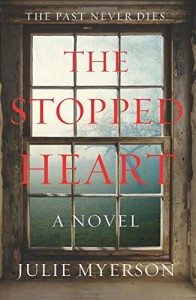 As a dedicated book
As a dedicated book maniac reviewer, I try and keep up with the cutting edge UK literary press. I’ve been intrigued by an emerging genre which I’ll call the ‘creepy yet quaint British village ghost story*’.
The Stopped Heart has been touted as such — a haunted house story set in the English countryside, with edge-of-your-seat suspense. Given its many stellar reviews and an enticing cover –I leapt in.
I know it’s been overdone, but The Stopped Heart is, at first, boringly set in two time periods, and (yawn) has two narratives – one in the present with Mary and Graham Coles – and the other, over 150 years ago with the farm family who once lived in the Cole’s cottage.
Delving further into what seems to be a predictable haunted tale, it’s not only the Coles’ cottage which is haunted — so are Mary and Graham. They have escaped to this countryside retreat to recover from a tragic loss. In the same cottage, 150 years in the past, Eliza narrates her large family’s hardscrabble farm story. Her sister, Lottie, strangely speaks of the present day family as if she knows them — and even names her kitten “Merricoles”, a version of the name “Mary Coles”. Ghosts, spirits, a haunted cottage — so far – so good, right? Get me another cup of tea and I’ll keep reading.
Except it all starts to go very, very wrong when the mysterious red-haired James Dix enters the circle of Eliza’s family. Thus begins the disturbing spiral involving both time periods and parallel stories of betrayal, underage lust and ultimately, grisly violence. And like an ill-advised roller coaster ride, you know, with dread, whats coming — but there is nothing you can do to get off. You’re strapped into the ride and you just gotta hang on and keep reading.
Ms. Myerson gives no indication when her narrative switches from one time period to another. I realized midway through the novel, that the author does this deliberately to enhance the fluidity of her past and present story-lines. The Coles’ modern-day cottage still harbors the violence of the past and Eliza and Lottie can sense the tragedy in the future. This can get confusing if you’re not paying attention. But, pay attention you will, because while creepy and often violent — The Stopped Heart is a compelling page turner. (Fair warning to any parents of young children out there, this book contains violence with young children as the victims.)
The modern day Coles struggle with their broken relationship, a surly teenage step-daughter and a sad flirtation with a neighbor. In the past, Eliza discovers her own budding sexuality, while simultaneously demanding her own (often funny and spunky) feminist beliefs. Meanwhile, the mysterious red-headed man disrupts everyone in both time periods. Some of the most intriguing writing involves Mary Coles “seeing” her kitchen and garden morph into the past. The smells, the dirt, the old furnishings all come alive through her eyes.
At the end of this gripping read, Ms. Myerson purposefully leaves many things unanswered – you won’t arrive a pat ending – creepily, you’ll continue to dwell on the events long after you’ve closed the book.
The Stopped Heart lead me to the edge of horror fiction, another blogger aptly labeled it “horror light”. I resolutely avoid horror fiction, I’m still recovering from my one (and only) Stephen King novel many years ago.
So why did I keep on reading well out of the limits of my comfort zone?
I kept turning the pages because of the writing. This is an intensely dark reading experience interspersed with beautifully captured characters coping with loss and unspeakable tragedies — the suffering of a stopped heart.
I recommend The Stopped Heart with caution and warnings (see above) and it had everything stacked against it for me (i.e., horror light). Yet, I had to keep reading and never once looked back. Which says a great deal about the appeal of this book – a scary roller coaster ride — you want to get off — but you can’t stop enjoying the thrill.
*Others in the same genre include Susan Hill, The Woman in Black and Sarah Waters, The Little Stranger…both on my TBR list — maybe, once I recover.



